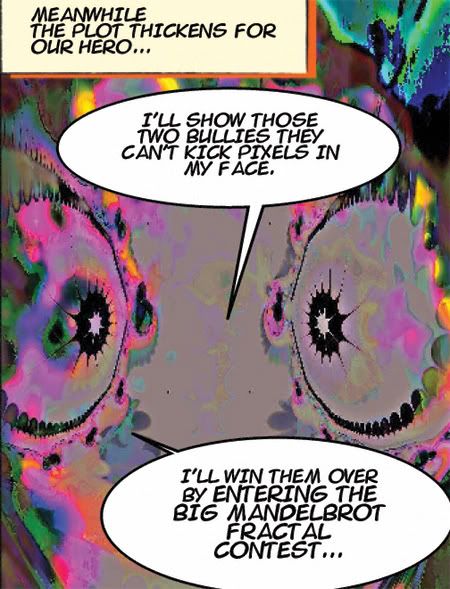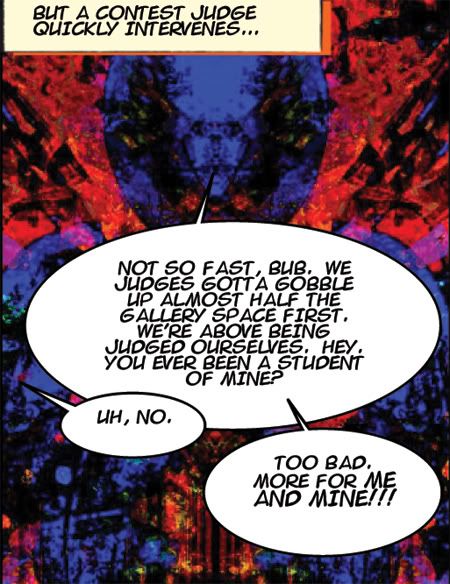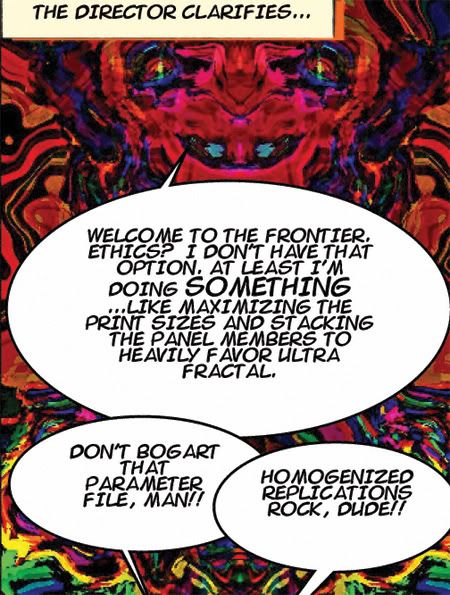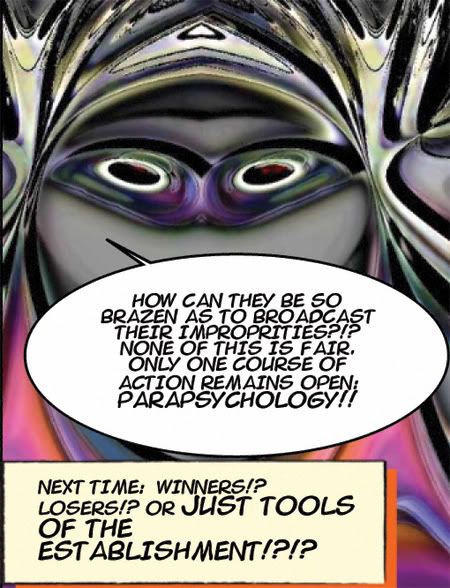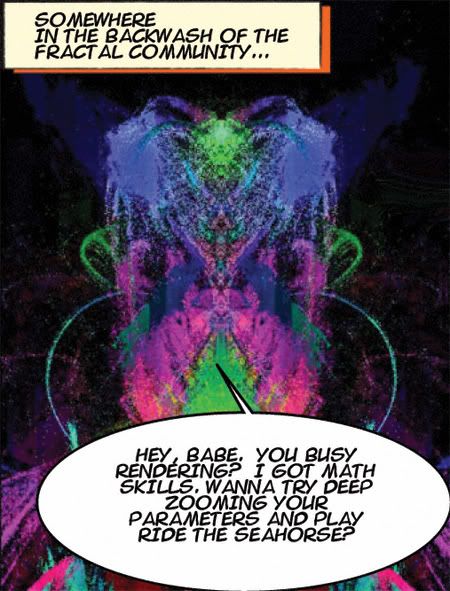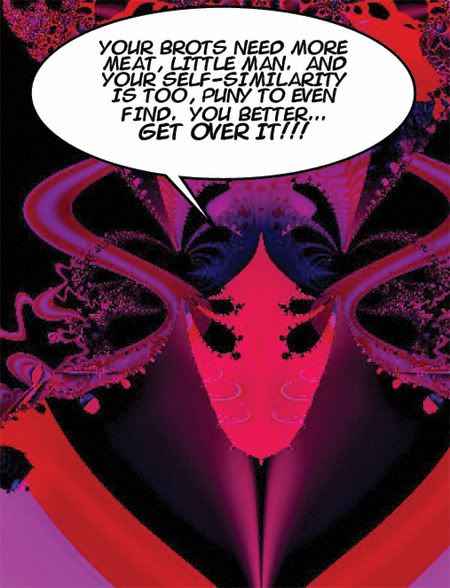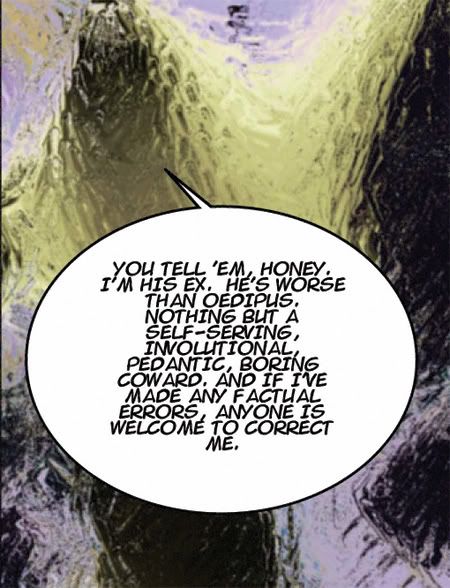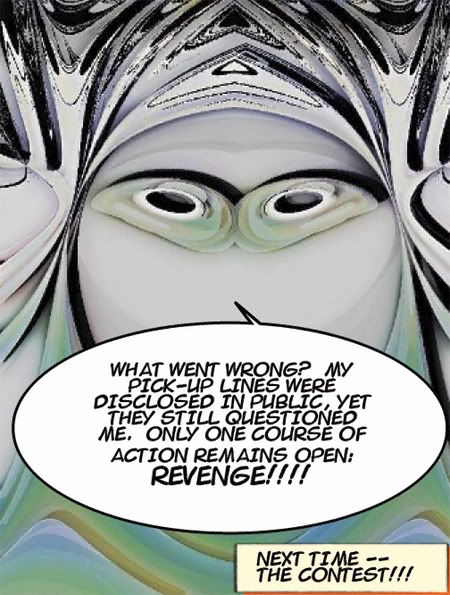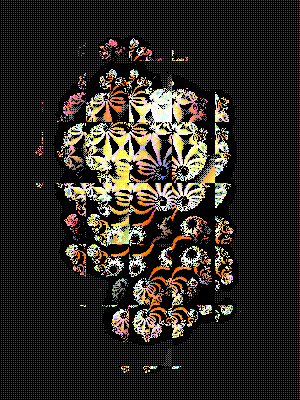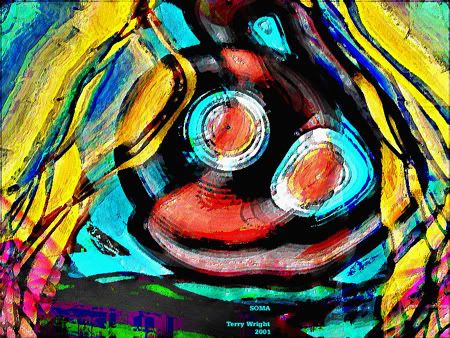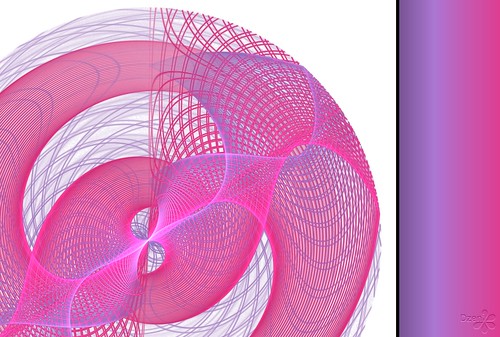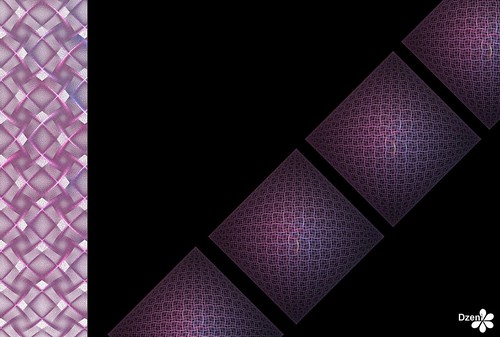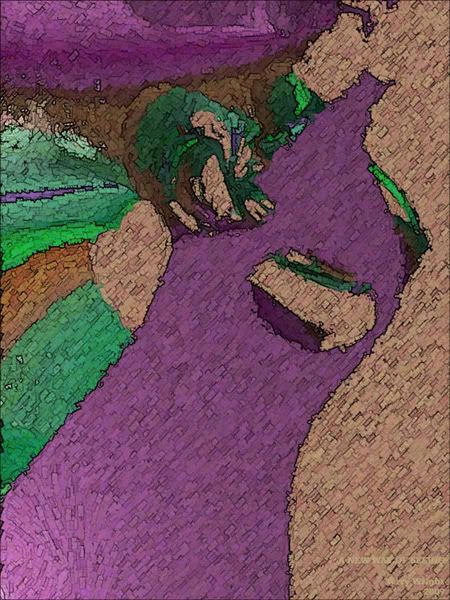Thus conscience doth make cowards of us all.
--William Shakespeare, Hamlet
I know it is sometimes difficult to speak out. There can be consequences. One might be embarrassed -- attacked -- even punished. So far, only one person has spoken out directly to us here at Orbit Trap about our remarks on the Benoit Mandelbrot Fractal Art Contest.
And he wrote to call us cowards.
He feels we are cowardly because "you don't address any points made to your posts."
So I think I'll make the time to show him he's wrong. I hope, in the process, the blog's readers come to better understand why Tim and I have raised our voices against some of the practices of the Benoit Mandelbrot Fractal Art Contest -- and have questioned the motives of some of the people involved.
In my last post, I deliberately mentioned no names. But since Ken, a commenter who seems to want to play the role of our collective conscience, used names, then, for the sake of clarity, I will do the same.
Funny thing about a conscience, though. Sometimes, as Hamlet notes, it nags and aches and does cause one to fear and fall silent. But, other times, it sears then scorches until one feels compelled to speak out.
I have put this response up as a main post. I would not want to be accused of speaking while milling about in shadows. If Tim and I are cowards, we are not the kind who prefer to hide.
~/~
Ken,
You've written to us so much lately that Tim and I are ready to promote you from heckler-in-residence to contributor emeritus.
Unfortunately, I seem to be in a bit of a bind here, though.
First: Damien says, in a post earlier in the summer on Orbit Trap, that I "killed" OT "by driving off everyone" who had an opinion different from mine.
Then: you claim, in the comments for this OT post, that "you're cowards because you...ignore direct questions."
I think this is called a Catch-22. If I do respond, then I am a tyrant who quashes free speech. But if I do not respond, then I am a coward who hides from his critics.
So which is it? And what should I do?
Wasn't it Orwell who said a picture of the future could be imagined as "a boot stamping on a human face forever"? I guess I'd rather be the boot than the face.
First, can we get a few big concepts straight? Then we'll get down to some specifics.
You're right. Contest organizers and directors can establish any ground rules they like. They are free to dictate restrictions on programs and image sizes and colors and styles and whatever. They can limit a contest to just fractal artists of Burmese heritage who live in the Arctic Circle. Totally their call. I never argued otherwise.
Countries can do the same. They can make their own rules. Rules like we'll throw you in a gulag if you protest or we'll bind your feet if you're born a girl or we'll torture you and call it "enhanced interrogation techniques" or whatever.
Here's the catch. Just because contests and countries have the power to make rules, it does not follow that those rules will be inherently ethical or fair. If they are, in fact, unethical and unfair, then people (at least in free societies) have the right to say so. You agree?
Being informed of rules is not usually a problem either. Nearly every contest spells out its requirements and guidelines in very specific detail -- ranging from deadlines to restrictions to oh-by-the-way-we're-going-to-include-the-work-of-the-judges-who-judge-you to whatever. I never argued that the BMFAC contest was not clear or open in stating its rules.
Countries usually make their rules known, too. I recall seeing a photograph last year of two Alabama water fountains in the 1950s that said WHITES ONLY and COLOREDS ONLY. See? The rules were plain to everyone. Nothing was hidden.
But, again, just because a contest's regulations are posted and public, it does not inherently follow that they are ethical and fair. Are you with me so far?
The contest's origin and history were also explained -- even outlined. True. But having a history doesn't mean everything is above board. Enron had a history -- but it was not above board. Bosnia has a history -- part of which included ethnic cleansing. Maybe everything is and always will be shipshape. Or maybe a contest was set up well but has become corrupt over time. Or maybe it was rigged from the get go and now everyone just shrugs and glumly accepts the terms. But, again, having a history doesn't give contests or countries an ethical pass. In fact, sometimes when digging into a contest's history, one uncovers questions.
Sponsors of contests can, once again, dictate absolutely anything -- especially since they hold the purse strings. They are, in truth, demi-gods of absolute power. All fractal artists must show up at the exhibition wearing thongs decrees one. All images must be created with an Etch-A-Sketch while submerged in tequila shouts another. As a contest director, you have to decide if you are willing to agree to the sponsor's terms. If you agree, then you are bound to carry them out -- even if they are absurd -- or troubling -- or patently unfair.
I hope this prologue deletes a few items from our mutual Inbox before we begin.
Now, Ken, you seem to really want some point by point rebutting. I'll try to suppress my timidity and start:
You want the entries of the selection panel hidden.
No. I want them completed excluded. Banished totally. Outta there. No entries -- period. They are the judges. They are not the contestants. Most people agree there is a big difference between the two.
BTW, where is this list of "universally accepted protocol[s]" that you like to mention?
Oh -- just about everywhere. I'd argue no respectable, legitimate art contest mixes the judges' work with the work of the judged. In the digital art field alone, there are contests by acronyms like MOCA, LACDA, ARTROM, MODA. The Art of Digital Show recently completed a major competition. None of these entities mix and match like BMFAC. Restrictions on conflicts of interest -- like judging the works of students and friends -- are also commonplace. I quoted one of these in my post, but I guess you missed it. But let's throw the ball back in your court. Can you name any five art contests anywhere that do allow inclusion of the contest judges' work. Well. Okay. You're right. The Fractal Universe calendar. You can have a head start here. That one counts for your side -- I suppose -- adding a second sorry blot on the overall lack of professionalism in the fractal art community.
It is disingenuous to keep raising this as an ethical issue when it was clearly the decision of the sponsors.
Maybe last year. Maybe. But the sponsor this year (Fundación España Vodafone) must be telepathic, since the contest rules were announced many weeks before any sponsor was even named. No, I'm afraid the director and/or the judges are most likely responsible. Besides, even if past or present sponsors insisted on such guidelines, no one had an automatic weapon to the heads of the director and the "panel members" to insist they comply.
You want to force the organizers/sponsors of the contest to conform to the rules you want, rather than the rules they choose.
Nope. I'm just pointing out that the rules are highly unconventional, biased to help a specific program and its artists, and give the judges a one way free ticket to paradise. Ally ally in free.
Since you can't affect the rules for this contest, you want to raise bogus ethical issues about it. That is why I say create your own contest or exhibition and run it by the rules you think an exhibition should be run.
Yes -- to the second part of the first sentence -- minus the "bogus" part. I explained why I shouldn't have to make my own contest in a previous comment. Remember? I used an analogy to not wanting to write my own laws either. Apparently, you've forgotten. And I can certainly appreciate all the expense and effort involved. I really can. I just appreciate ethics and fairness more.
You see, back in that "written record" that you feel already explained everything, Damien said the following:
So I have a choice: I can either run a contest completely how I would like, and pay for it myself, or I can accept money from a sponsor that comes with conditions. What you're saying is that you find the strings unacceptable. I'm saying that, given the choice between no exhibition and one with some preconditions, I'd prefer to have the exhibition. At least I'm doing *something* Years from now, when fractal art is more recognized and easier to get funding for, others will have the privilege of refusing money that has strings attached. At the moment, I don't have that option.
Yes. He's doing something, all right. Something ethically questionable. He argues he's on the frontier, so he can bend the rules. There's no law or justice out on fringes of civilization, so Damien is forced to become judge, jury, and exhibitioner. Later on, when fractal artists have their own cable channel, others can run things "without preconditions" (that is, fairly). Well, that's swell. Or maybe what happens instead is that a "history" is put in motion, and the contest is never again run using customary ethical safeguards. Damien says he didn't have "that option." But he did have a choice and he made it -- and he now enjoys its benefits -- like having his own unjuried art worked into the contest he oversees every year. Some of his friends/panel members made choices, too, and soon hopped aboard without giving much thought to the "preconditions" either. They, presumably, also didn't have "that option" but do receive similar compensation.
Even the director knows the rules are being bent. He's fine with that. So are you, Ken. But I'm not.
You don't like Ultra Fractal.
I've never said any such thing. It's a great tool and capable of producing amazing work in the right hands. What I don't like is making submission size restrictions that favor UF over other programs -- and loading up the judging panel with nearly all UF artists -- and then winding up with the majority of the contest's exhibited images being rendered in UF. Could it all just be a coincidence? I'm just asking...
You think images are excluded because have not been generated by Ultra Fractal.
I think that's a real possibility, yes. UF can go huge. That's one of its advantages. Not every generator can easily render images to the mammoth size required by the contest. The director knows this, too -- otherwise he wouldn't have made a joke in the contest announcements that Apo users should Start now if they are planning to enter. More than just fractal programs are affected by the size mandate. People who post-process to a considerable extent are also going to be less likely to enter.
You don't like artists works who use Ultra Fractal.
Certainly not true. I have featured many UF artists and artworks in the guest galleries on my web site. Would I have done so if I didn't like the artists and their work? I'd put up a link to show you these galleries, but, unfortunately, they are now offline because I had to unexpectedly move to a new web host and procure a new domain.
A better question to ask is how many people submitted images that were not made with Ultra Fractal. And, if the number is small, ask yourself why.
Hmmm. I never thought to do that. But it is a good question. Here's a possibility. Maybe many non-UF artists' programs couldn't render large enough images to meet the near-mural size restrictions. Could that be why the number is likely smaller? Thanks for the insight.
You think Damien is a dictator.
I never said any such thing. Besides, everyone already knows what Damien actually is.
You don't like having to produce a large image.
You've obviously never watched me make my art. I always work in large sizes. That's how I'm able to sell prints. I had no trouble rendering entries for the contest -- and two of my submissions were highly post-processed. But I'm fortunate to have plenty of RAM and lots of computer firepower. So, I don't need UF to scale up. I'm guessing many fractal artists are not so fortunate in the equipment they have at their disposal. Thus, the immense image sizes are indeed a hindrance for some.
You don't like artists taking classes from other artists and participating in a contest.
That doesn't bother me at all. What I said was I think teachers judging the work of their students is a clear conflict of interest. I linked to two examples in my post. I also asked what safeguards were in effect to prevent this kind of thing from happening.
But, since you know the circumstances behind the exhibition (no matter how much you pretend to be ignorant), this really is just nonsense.
You lost me here. Are you saying it's foolish to worry about students being judged by their instructors? I think it's highly unprofessional. Or, are you telling me the contest guidelines addressed this issue? Where in the BMFAC rules did it say: Teachers judging the work of those they taught? Sweet. Well, if you already have judges exhibiting their own work with those they've judged, I guess anything goes.
You would like to have anyone who ever took a class from any of the judges to be excluded from entering because you think the judges are so shallow that the mere fact that a current, or former, student entered an image in the contest is going to sway their decision.
I guess you have more faith in human nature than I do. I'd prefer judges not to judge the work of their students -- or their friends either. Why not simply remove such potential conflicts of interest? Again, it's a basic question of professionalism -- even if one believes the judges are fine people who would not be swayed in any way.
I suppose it is possible that one or more of the judges may have recognized an image and knew who created it. But, for this contest, do you really believe that this is significant, or an ethical concern?
Definitely. Always. Any judge who recognized the work of a friend or a student should have immediately recused him or herself from voting. Moreover, this action (that so-and-so was a friend/student of Judge X) should have been kept from the other judges. Adding to this problem was that the judging could not have been completely blind because the images of three of the fifteen winners contained signatures. Do you want an impartial contest or not, Ken?
You don't like people show appreciation to someone else for writing a particular formula.
This is not what I said. Slap backs all day. I said I worried that since many of the winners are trading the same formulas, one runs an increased risk of presenting a show of similarly styled artworks.
You think there is a grand, universal conspiracy by Ultra Fractal and/or those who use it to take over the world and prevent any one who uses other tools or methods to create fractal...
No, I don't. But I'm pretty sure Paul does. He calls this secret cabal The Fractali. I assume he took the name from the Illuminati. Personally, I think Paul is a smart guy. He could be right.
You continue to imply that there are ethical issues with Damien and the panel of judges by the questions you raise when you know how and why they were selected.
Exactly. You're finally starting to get it. They basically selected themselves, set themselves apart from being juried, judged others, and then hung their work beside the winners.
How can the contest be a publicity stunt by Damien and the judges when they were approached by the organizers and asked to participate?
As I noted earlier, the rules this year were set long before the organizers had a sponsor. Here is how Damien explained several months ago in the "written record" (to your satisfaction) why the contest judges had to be included in the exhibition:
I am well aware that people were not happy about judges' work appearing in the ICM exhibition alongside contest entries, but we made it clear from the outset that contest entries would not be the only art shown. This year is no different. The sponsors require this as a hedge against insufficient quality being submitted.
Glad to know I'm not the only unhappy camper. Again, if this is true, Damien signed on to the terms. But who held his feet to the fire? And why was "this year" (2007) no different -- especially when a sponsor wasn't listed until weeks after the rules had been made public? Sounds like everything just got carried over. However, at least in the current contest, there's a whole battalion --55, count 'em --of exceptional "alternates" and "honorable mentions." What good fortune -- especially since most art contests only manage to scare up about 5 to 10 HMs. But Damien is now lucky to have excellence to burn -- surely more than enough to take up the slack for all those sponsors' fears of "insufficient quality." So, it looks like next year the director and the judges can finally breathe a sigh of relief and not be coerced by preconditions into displaying their own work. Right?
Did they conspire to take over the contest and mold it to a form so that they could make an exhibition to flaunt their own art?
Looks like it. Absolutely. Down to the last detail. Give yourself a Gatorade shower. I couldn't have said it better myself.
Other complaints you raise are emotional and ill-reasoned. I would expect better of you and Tim.
And, well, if pressed, we pretty much feel the same way about your comments.
But, your complaints must be objective to have any merit.
I think we've tried to look at the contest and honestly report what we found. And are complaints the same as opinions? If so, then they are probably, like art, subjective.
If I've made any factual errors, anyone is more than welcome to correct me.
Well, I've tried my best. As for errors in logic, I admit there were more than I could get to.
It would also be interesting to see perspectives from other people, pro or con.
Finally -- something we agree on. I, too, would enjoy hearing what others have to say about the Benoit Mandelbrot Fractal Art Contest.
I'd like to think Hamlet might have been wrong. Conscience only makes some of us cowards.
~/~
Technorati Tags: fractal, fractal art, fractal contest, digital art, Benoit Mandelbrot Fractal Art Contest, ultra fractal, fractalus, vodafone
